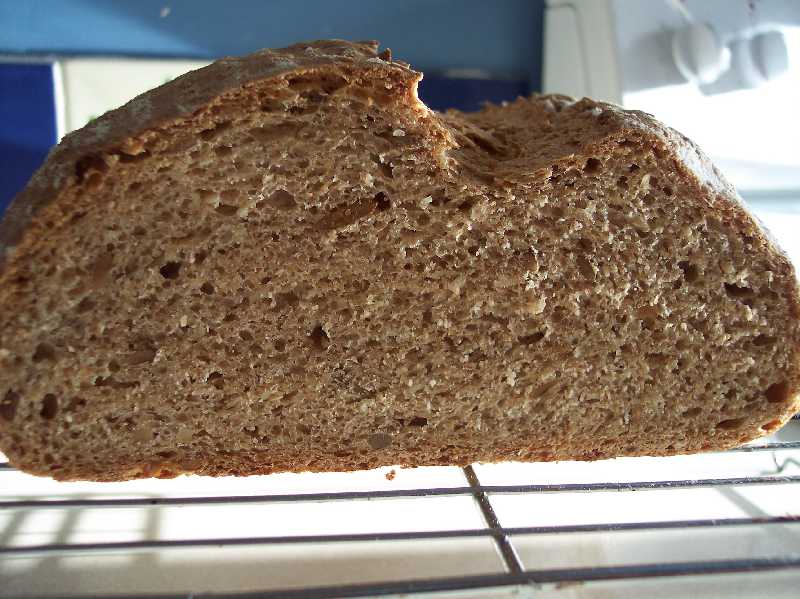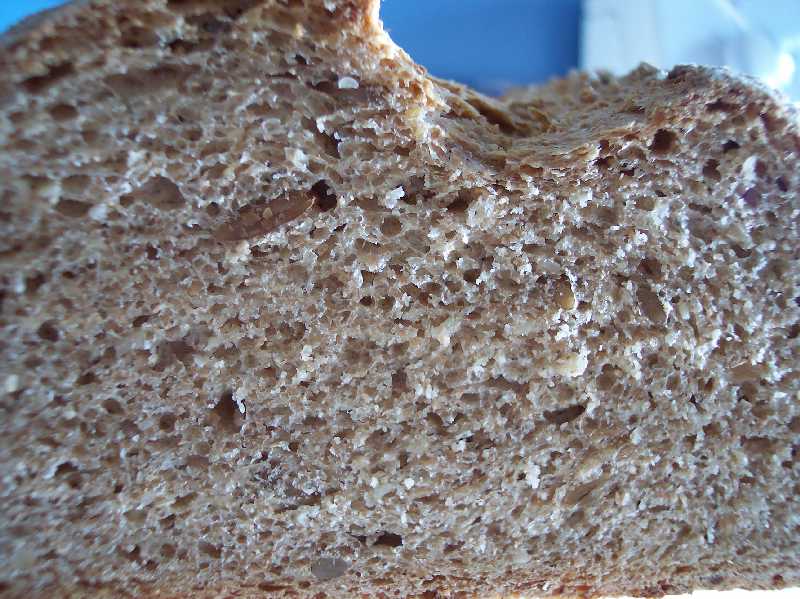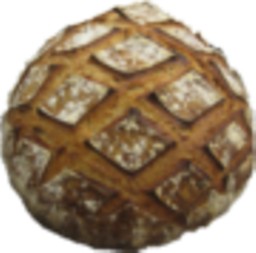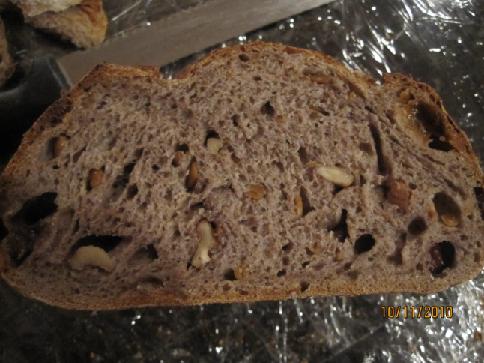Three bakes this weekend—from the lean to the…not! All were good to eat, and all contributed to my learning process.
Honey-Oatmeal Sandwich Loaf
In my quest for a good multi-grain sandwich bread, I decided to try Oatmeal-Cinnamon-Raisin bread (Floyd’s recipe from Hamelman posted here: http://www.thefreshloaf.com/recipes/cinnamonraisinoatmealbread), but without the raisins and cinnamon. It is a very large recipe—made for three 8.5 x 4.5 pans—from which I made two loaves in 9 x 5 pans. The oat soaker had very little free water and the dough was too dry to blend with the prescribed quantity of liquid (honey, oil, water and milk), so I added about another half cup of water. It was still the densest dough I’d made and very hard to mix by hand. But it came together after about 15 minutes of on-and-off folding and resting.
The large quantity of yeast did the job of loosening up the dough ball in the first ferment, and it pre-shaped and shaped nicely. The loaves came out very well. Very much the texture I was looking for, moist but not squishy. It was great for toast and for BLTs. This formula would make good hamburger buns, I think. My one adjustment, besides the added water, would be to increase the salt by 25% if doing this recipe without the raisins and cinnamon. The recipe is simple and the whole process only takes about four hours from start to sandwich.
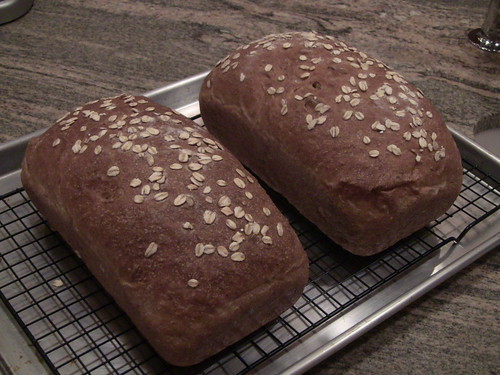

This bread passed the PB&J test with flying colors.
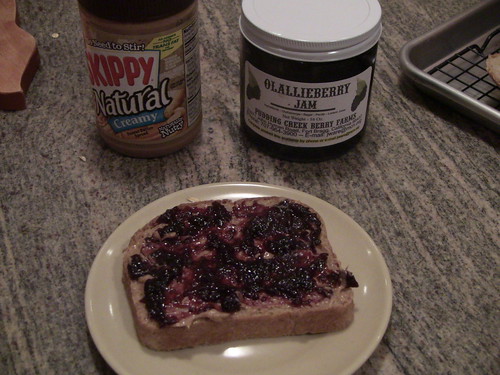
Anis Bouabsa Ficelles
After my first try at baguettes—using San Joaquin Sourdough—came out pretty well, I decided to try a higher hydration dough. Going for the crispy crust and open crumb, I settled on the Anis Bouabsa formula Brother David has posted (http://www.thefreshloaf.com/node/9839/ficelles-made-anis-bouabsa039s-baguette-formula”). What an adventure for a near-novice! The headline for this story could be “Everything went wrong except the results”.
I mixed the dough easily, a complete texture contrast to the Oatmeal bread. The dough was very sticky and almost batter-like for the 10 minutes or so of hand-mixing. With each stretch-and-fold-in-the-bowl, the dough got a bit more cohesive and silky, but was still very loose. With a bit of flour on the board and my hands, I managed to do the last two stretch-and-folds with the majority of the dough cohering in the dough ball. Then, into the cold fridge for 18 hours (I didn’t have 21 hours to play with).
The next afternoon the single-handed Three-Stooges-Meet-Molten-Gumby-Snake routine began. I read that one should use no (or very little) flour on the board in shaping baguettes. Because the dough was super-gluey, my choices were to flour the board and my hands or to maul the poor defenseless breadlings into indescribably grotesque deformations. I chose flour. Even so, each little (180g) dough glob was a handful. The pre-shaping was fairly simple, with help from a dough knife. Then I rested them on a rice flour/AP flour mix on the board for an hour. In final shaping, I tried to use a light touch, but found myself spending most of my effort in keeping the globs together and off my hands. They eventually got formed into more-or-less cylindrical shapes, about 13” long. Extremely extensible. Wrestling the semi-liquid snakes onto my improvised couche (parchment atop a big flour sack towel) was comical. I had visions of the snake extending to 20 or 30 feet and wrapping my entire kitchen in its gluey grip. But dusting them all over with the rice flour blend did the trick, and the ficelles did not stick too much to me or the plastic wrap.
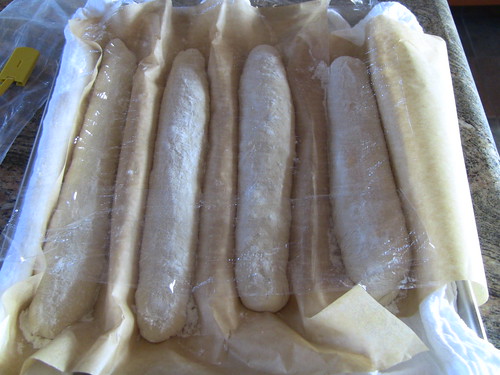
Scoring was likewise a mess. The sharp and wetted lame continually dragged the sheath of the ficelles. That maneuver will take more practice. Then, when I tried to load the ficelles, on parchment, from the “couche” to a cookie sheet to the baking stone, the four snakes would not fit nicely on the stone with all the parchement. So, while the oven temperature dropped, I scissored away some of the parchment, arranged the snakes on the stone, steamed, and slammed shut the oven door. I was sure the bread would be as far from my ideal as the process was.
Wrong! Though not much grigne, there was good oven spring.

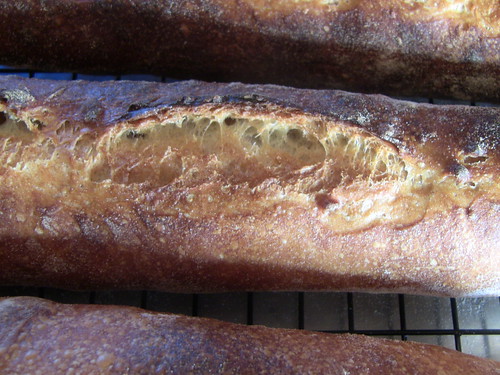
And the crumb was exactly what I was going for—holey but with some substance to chew.
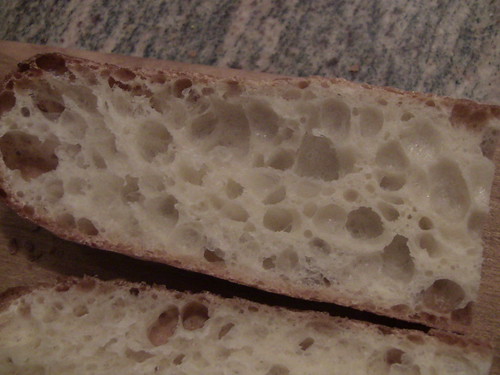

The texture is wonderful. Very crisp thin crust, with a creamy crumb. My wife says it is the perfect baguette except she prefers some sourness. So, my next baguette experiment will be a slightly lower hydration dough with levain.
Pizza, Pizza, Pizza!
After the pizza discussion on my last blog post, I had to try a totally lean pizza dough, with just flour, water, yeast and salt. I used the PR Neo-Napalitano recipe but with no honey or oil. We had guests over and made two pesto and sausage pizzes, one with fresh corn and one with tomato. The fresh corn and sausage combo is a winner. Our guests loved the baguette and the pizza. They think I'm a baker [heh heh].
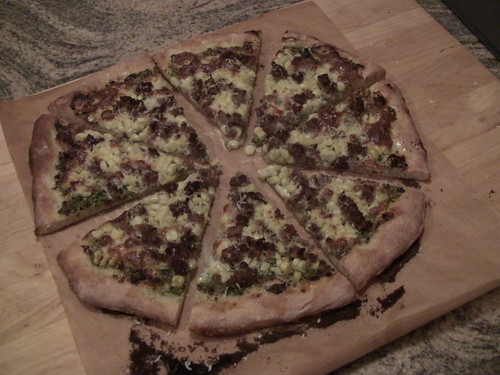

The pizza's outer handle wasn't as puffy as the enriched recipe, but the texture was excellent. Next pizza will be with real 00 flour.
So all told, it was a weekend of baking variety. Some lean, and some not. If I’d made cinnamon rolls, too, I would have hit for the cycle.
Glenn



